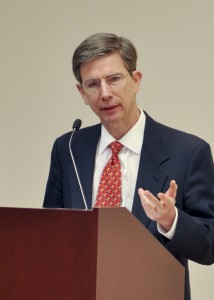The National Bureau of Economic Research may have declared the financial crisis of 2008 as officially ending in June 2009, but that”™s not reality to the millions of Americans still unemployed and to homeowners struggling to stave off foreclosure.
Joseph Tracy, executive vice president of the Federal Reserve of New York, shared his personal observations of the effects of the economic crash with more than 100 members of the business community at Dominican College Jan. 28.

“The Great Recession didn”™t earn its moniker due to its length,” Tracy said. “Rather, it distinguished itself by its severity than by its length. In most recessions, consumption growth slows but remains positive; in this recession, there was an actual decline in consumption rather than a slowdown.”
Tracy said the decline of auto sales and housing starts came as no surprise. “When households need to cut back on spending, they typically start with durable goods ”“ typically delaying the decision to replace a car or trading up to a nicer house.”
In order to realign production to the declining level of demand, firms quickly cut staffing levels, resulting in a rapid rise of unemployment across all age groups. “From the peak in December 2007 to the end of the recession, private, nonfarm payroll employment declined by 7.3 million jobs, bringing employment below its January 2000 levels,” Tracy said. “This recession”™s severity is very apparent when you realize an entire decade”™s worth of job growth was lost.”
Household wealth declined both in equity and real-estate wealth. But household saving rates, said Tracy, increased in reaction to the negative shock. “Several factors were likely behind it ”¦ households likely increased their savings to begin to rebuild their wealth; and because of the deterioration in the labor market, households took on a strong precautionary attitude to help buffer consumption in the event of a job loss.”
The Federal Open Market Committee (FOMC) reacted aggressively in response to the recession and financial crisis. “The FOMC quickly lowered its policy rate, better known as the federal funds rate, to zero. The aggressive pace for lowering the fed”™s funds rate reflected the lessons learned from Japan”™s earlier experience in dealing with a housing market boom and bust. At the same time, it increased its provision of liquidity to the financial system. Up until the Lehman bankruptcy, the FOMC provided this liquidity without expanding the size of its balance sheet.”
When Lehman imploded, the FOMC could not provide the additional support to the economy in the traditional manner, since the policy rate was already set at zero, Tracy said. Instead, FOMC initiated the Large-Scale Asset Purchase (LSAP) program, the objective to ease the financial market conditions by providing more support to the economy. A consequence of the LSAP program was a rapid expansion of the central bank”™s balance sheet.
The combined monetary and fiscal support for the economy helped arrest the decline in economic activity, he said. “As sales began to stabilize, firms were able to manage down their inventories ”¦ with excess inventory worked off, firms needed to meet demand by increasing production. Aggregate industrial production rebounded, especially for durable goods. Growth also improved aboard, increasing the demand for our exports.”
Though profitability improved, Tracy said, market conditions did not lead to a decline in the unemployment rate. Tracy determined there is an approximate total of 15 million unemployed workers, with another 9 million working part time as an economic necessity and  an additional 1.3 million “discouraged workers” who have given up the job search and therefore not included in the unemployment figures.
As firms started to restore part-timers to full-time positions and increase total hours, it has not helped to reduce the unemployment rate, Tracy said. “As conditions continue to improve in the labor market, discouraged workers may renew their search for a job. This re-entry pushes up the measured unemployment rate until these re-entrants find new employment.”
Due to concerns of a double-dip recession, the FOMC decided to restart its large-scale asset purchases by announcing an intention to buy an additional $600 billion in Treasury securities. “Again, as with the earlier asset program, the intent was to improve the financial market,” Tracy said. “Subsequently, a compromise was to extend the Bush tax cuts ”¦ the flow of economic data indicated the economy was, in fact, regaining its lost momentum. Economists began to mark up their forecasts for 2011.”
The recent improvement in the economic outlook is welcome news, he said. “We should keep in mind, however, there is considerable uncertainty associated with every economic forecast. There are both upside and downside risks that could cause actual economic growth to deviate: one important downside risk is associated with the housing markets. There still remains a significant excess supply of housing that will exert downward pressure on house prices and new construction. The foreclosure pipeline continues to grow ”¦ at best, we are only halfway through the resolution process.”
Lessons from the Crash of 2008 were twofold, Tracy said.
“The Great Recession is appropriately named because it reminds us of the severity of what took place; it also reminds of the aggressive monetary and fiscal policy actions undertaken both here and abroad. Much was learned ”“ and much remains to be learned ”“ about how to prevent this from recurring in the future.”

















